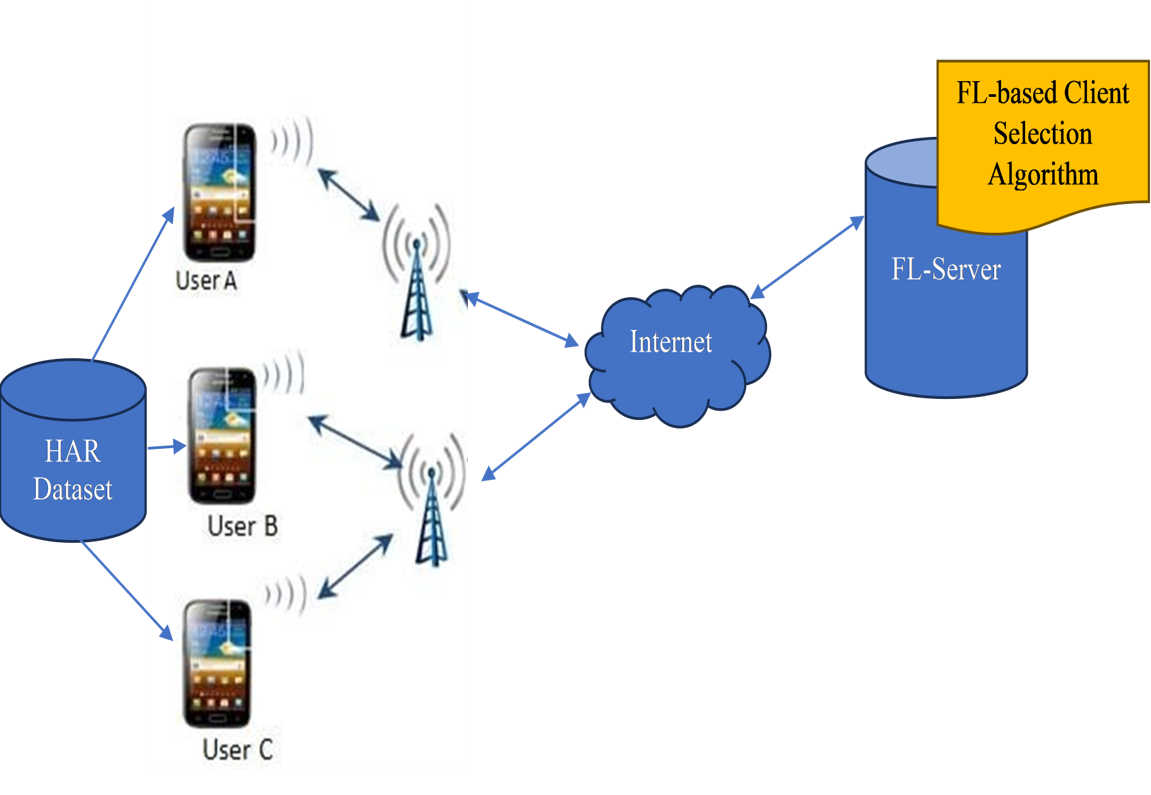Title:PNRR project FAIR – Future AI Research (PE00000013), Spoke 9 – Green-aware AI.
Sponsor:NextGenerationEU
Duration: January 2023 - December 2025 (Ongoing)
Role:Researcher
Project Overview: The objective is to develop disruptive radical technologies in the area of Green AI with specific applications in the domains of Internet of Vehicles and Internet of Wearables.
Members who worked:

Thesis Title: An Efficient and Intelligent Human Activity Monitoring and Recognition Framework for Smart Healthcare The objective of this thesis is to provide both the online and offline end-to-end HAMR frameworks. In addition, this thesis addressed several research gaps that are identified in the Machine Learning based HAMR domain. Online HAMR framework uses the real-time data stream to monitor and recognize human physical activities using smart devices such as smartphones and smartwatches for early disease prediction. This thesis aims to examine the difference in HAMR using machine learning time series and deep learning networks. The goal is then to examine collected data, data segmentation, feature engineering, classification, and compare efficiency. In this thesis, online, real-time smart device-based data is used to monitor and recognize human activities and predict disease. In this context, an efficient and intelligent framework has been developed to monitor and recognize activity for disease prediction.
Collection of smartphone and smartwatch-based human activity dataset using accelerometer and gyroscope sensors and then preparation of the dataset using various preprocessing techniques to monitor and recognize various static, dynamic, and transitional activities.
Extraction of statistical features and exploration of various feature selection techniques with the aim to propose a novel feature selection method, namely, Modified Guided Regularized Random Forest (mGRRF), to address the "curse of dimensionality" and "overfitting" issues to enhance the accuracy of the proposed activity recognition framework.
Exploiting a novel ensemble learning model and an optimized feature extraction method in order to recognize activities with proper visualization of the data using t-SNE.
Development of a novel Random projection-based ensemble extreme learning machine classifier, namely "SRHT-ELM-HAR" as the combination of two distinct problems - dimensionality reduction of the high-dimensional feature vector and classification of various human activities to address generalization, slow learning rate, and overfitting issues.
Investigation of a selection method for extracting non-linear features instead of the traditional selection of linear features in activity recognition tasks. Non-linear features are important to find out the dependency and interactions among various activities and to recognize them accurately. We adopt the GBFS method in place of an alternative non-linear selection method since it is demonstrated that it scales very well over a large dataset by automatically performing feature selection tasks. Feature fusion is performed between the selected features using GBFS and automatically extracted features using CNN to increase the performance of activity recognition.
Exploration of deep learning approaches to study the performance in activity recognition and development of a novel HAR framework that (a) can automatically extract features from unlabeled raw sensory data, (b) uses fewer parameters due to the presence of a convolution layer that minimizes the risk of overfitting, (c) reduces the required computational time and d) enhances the accuracy of HAR.
Development of an online change point detection algorithm to segment the online, real-time, continuous data stream in an unsupervised manner. It is used to group similar activity patterns and identify short-term transitional activities, including basic activities.
Development of a novel integrated DL architecture, attention-based CNN-LSTM architecture for extracting latent information from the long sensor data streams that are hard to handle by conventional LSTM-based approaches. To the best of our knowledge, this is the first approach to the proposed attention-based CNN-LSTM for hemiplegic gait detection, which efficiently integrates both the automatically extracted features and hand-engineered (handcrafted) features to improve the efficiency of the proposed model using smartphone sensors. The attention network constantly adjusts the significance of handcrafted and automatically extracted features to improve the efficiency of hemiplegic gait detection. The ablation study also shows the importance of the attention mechanism. The hemiplegic gait data is collected and preprocessed for early hemiplegia disease prediction.
Development of a novel attention-based multi-head DL architecture to overcome user-specific, device-specific, and position-specific issues that are implemented both in offline and online modes. In offline mode, the smartwatch-based collected data is sent to the PC for activity recognition. In online mode, the activity recognition mechanism is implemented on the smartphone, and the classification is done in real-time on an android smartphone.
Development of flexible activity recognition and real-time monitoring system (Flexi-HAMR) to identify different physical activities, such as transitional and complex activities. Moreover, the proposed system can learn any new activity automatically. The proposed system efficiently monitors and recognizes hemiplegia and Parkinsonian gait for early disease prediction using new datasets.

Thesis Title: JMS based Application for Cross-lingual Chat Server The objective of the project work was to create a cross-lingual chat application in which we can send message in different regional languages such as Bengali, Marathi, Punjabi and Hindi.
Thesis Title: Banking Management System for Employees The objective of the project work was to create a banking management system for human resource.